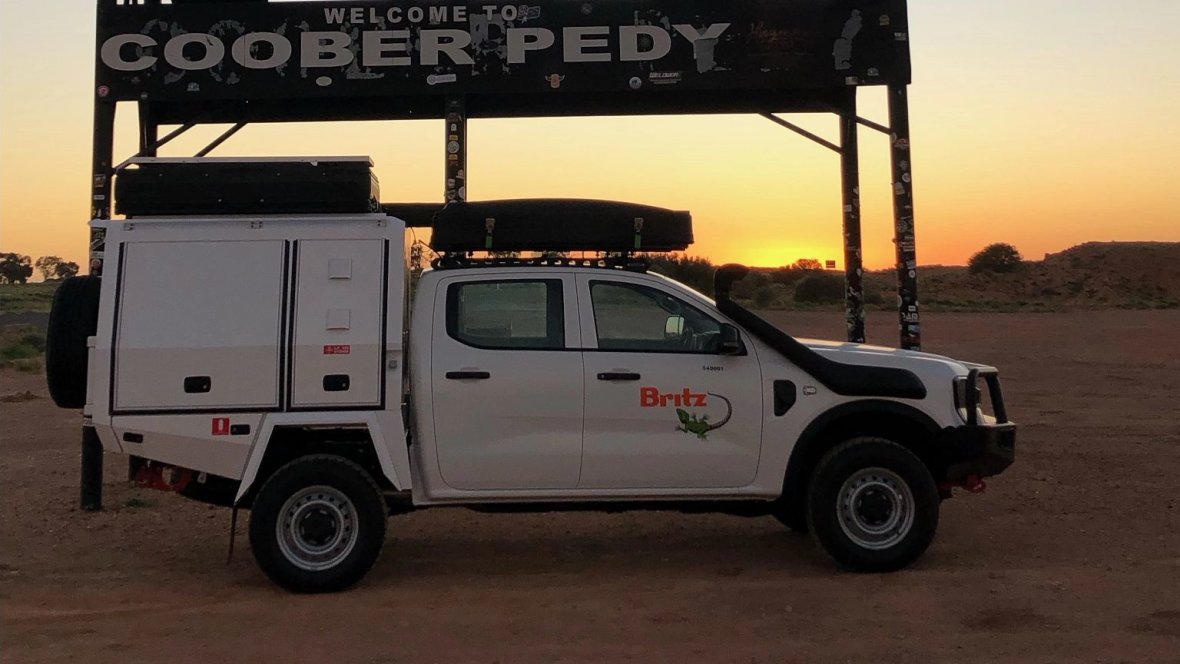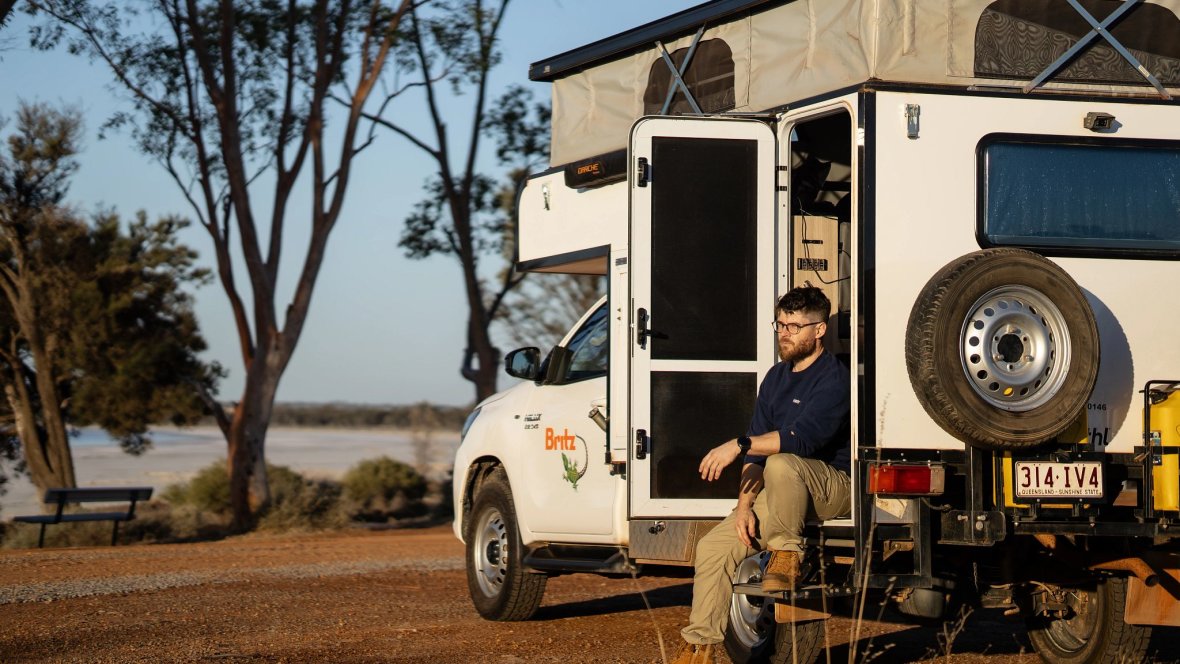


Join thousands of fellow campervan travellers
Sign up for our Britz newsletter to receive inspirational travel content and awesome deals, and we'll send you a copy of our Ultimate RV guide!
Thanks
Please confirm subscription in your email.
What is the Australian Outback?
Ask ten Aussies to draw the Outback on a map and you’ll get ten different squiggles. Culturally, “the Outback” is anything tucked off in the remote regions of Australia (read: where towns are tiny, horizons are huge, and phone towers are few and far between). Geographically, it covers roughly 70 per cent of the continent, stretching from the top-end tropics to the cool deserts of the south-west. And it isn’t all red dirt either, think spinifex plains, sandstone gorges, salt lakes and sprawling cattle stations the size of small countries.
Some of the most iconic Outback adventures include:
-
Stuart Highway—a sealed road dubbed “the Explorer’s Way” that bisects the nation from Darwin to Adelaide, perfect for motorhome roaming.
-
Great Central Road—an epic 1,100-kilometre dirt run linking Western Australia and the Red Centre via Warakurna Roadhouse; 4wd tyres strongly recommended.
-
Savannah Way—a 3,700-kilometre adventure across northern Australia, weaving from Cairns to Broome through tropical savannah and crocodile country.
And while many of these will kick you out into some of the most untouched corners of the country, not every Outback trip means rattling along corrugations. Plenty of sealed stretches let a 2WD camper cruise in comfort, while unsealed spurs and seasonal tracks reward those with 4WD muscle and a sense of adventure. Deciding which is right comes down to your route, your confidence and the conditions on the day.
2WD or 4WD – what vehicle should you choose?
2wd campers are purpose-built for sealed roads: smoother rides, better fuel economy and more living space - ideal if your bucket list centres on the headline acts reached via bitumen. 4WD campervan hire, on the other hand, swaps a few creature comforts for high clearance, low-range grunt and the freedom to follow those dusty arrows on the map. Need help deciding? Check out the full 4wd vs 2wd comparison article for the full breakdown of differences.
Okay, now what can you expect to be able to reach in a 4wd vs a 2wd? Let’s get into it.
Outback gems you can reach in a 2WD:
-
Uluru via the Stuart Highway - sealed all the way to the national park gate.
-
Broken Hill, the heritage-laden silver-mining city in far-west NSW.
-
Coober Pedy - yes, it’s in the desert, but stick to the highway and you can coast all the way into town to explore this town's rich opal mining history.
Tracks where a 4WD (and experience) is non-negotiable:
-
Gibb River Road (WA) for rugged gorges and knee-deep creek crossings.
-
Oodnadatta Track (SA) tracing the old Overland Telegraph Line.
-
Cape York (QLD), where red mud, river fords and hungry potholes are par for the course (not between 1st Dec and 31st May)
Does the 4WD option sound like the right one for you? If so, it is important to note that Britz requires written permission before you tackle many of these routes; check their current road restrictions page and the road restrictions 4wd list before finalising your travel itinerary.
If you’re brand new to bush tracks, why not cut your teeth on gentler 2 2wd-friendly loops first, or at least skim how to drive a 4wd for the basics of gearing, momentum and tyre pressure. Seasoned off-roaders can level up further with a 4wd packing list, tips on how to cross water in a 4wd, and even ideas on how to master your 4wd camping set-up for those star-soaked nights off the beaten path.
Plan ahead – understand Outback road conditions
Before you so much as top up the windscreen washer, get into the habit of checking Australian Outback road conditions—every single morning. Tracks can swing from dusty motorway-smooth to axle-deep sludge in one tropical downpour, and bushfires or accident clean-ups can trigger sudden Outback road closures.
The Northern Territory’s Live Road Report, South Australia’s Outback Road Warnings map, and Western Australia’s interactive Travel Map(handy right down to specific alerts) are your first ports of call. Local visitor centres, shire offices, and even the bloke pouring diesel at the roadhouse will often have the freshest gossip on a creek that’s risen overnight (he is probably the one getting the call out to help).
Why do tracks close? Flood damage is the obvious culprit, but you’ll also see seasonal shutdowns to protect fragile surfaces, closures for cultural events, and even temporary bans after a livestock spill. Ignoring a “CLOSED” sign risks a heavy fine, invalidates your insurance, and, frankly, rubs Outback etiquette the wrong way. Treat those barricades as gospel. We guarantee there’s always another stunning detour that you can add to your travel itinerary.

Fuel, supplies and safety essentials
Out here, the classic rule of thumb is “never drive past a servo with less than half a tank” (read: service station in Aussie slang). Some stretches between roadhouses top 300 kilometres, and a stiff headwind can guzzle more diesel than you’d budgeted for. Here is a little checklist to run through before heading into the Outback:
-
Top up your jerry cans (supplied with selected Britz 4WDs) and be sure to tick off the items in Britz’s comprehensive 4wd packing list—think 20 litres of drinking water per person, a decent food buffer, and any other necessities.
-
If you’re planning on heading far off-grid, then you may want to consider a satellite phone or at least a UHF because you don’t want to be relying on mobile bars out there. Every Britz camper or motorhome includes a first-aid kit and extinguisher, but extras—like a trauma bandage and a long-handle shovel—pay dividends.
-
Paper maps feel delightfully old-school until your GPS freezes; tuck a driving atlas beside the driver’s seat and preload offline layers in the thl Roadtrip App, WikiCamps, Fuel Map Australia and (for hardcore explorers) HEMA’s own app. These tools flag fuel stops, dump points, campgrounds and even the nearest shower block—gold when you’re three days into a dusty road trip in a hired campervan.
Most travellers who plan sensibly never face more drama than choosing which gorge to swim in first, but the remoteness is real. Share your route with a friend, check in via text whenever you get a signal, and you’ll join the thousands of Outback tourists who complete their journeys without a hitch.
Driving tips for sealed roads (2wd vehicles)
-
Drive in the day: Taking a 2wd camper down the Stuart Highway feels easy—until a kangaroo bounds onto the asphalt at dusk. For this reason, day-light-only driving is your best defence; native wildlife is most active at dawn and twilight, and headlights mesmerise roos into risky last-minute hops.
-
Avoid Highway hypnosis: Long, ruler-straight sections can lull even seasoned drivers into “highway hypnosis”, so copy the Main Roads WA fatigue advice and swap drivers or pull over every two hours.
-
Keep an eye on the mirrors for road trains: These three- and four-trailer giants may reach 53 metres, longer than an Olympic pool. If one looms behind, maintain speed and gently edge left so the driver can see ahead; when overtaking, allow a full kilometre of clear bitumen before pulling out and be ready for a buffeting side-draft.
-
Take breaks: Need a breather? Use signed rest areas, roadhouses or designated campgrounds rather than random verges, which can hide bull-dust pockets. Besides, a cuppa at a roadhouse café is half the fun of campervan hire life.
-
Respect the tempo of Outback driving: sit just under the speed limit, drop another 10 km/h if the temps are soaring or cross-winds pick up, and wave at fellow travellers. It’s good karma—and a gentle reminder that you’re living the Outback dream now.
Driving tips for 4wd adventures
If your heart’s set on those bucket-list tracks that most maps label “4x4 only”, here are a few extra Australian Outback driving tips to consider:
-
First, brush up on the fundamentals of how to drive a 4wd — from engaging low range to reading the terrain. On long sandy or corrugated stretches, drop your tyre pressures (use the guide in the Britz manual) and pack an air compressor so you can pump them back up at the next servo.
-
Water crossings are common on routes like the Gibb or Cape York. The golden rule for how to cross water in a 4wd is simple: walk it first, keep the bow-wave gentle, and steer clear of anything above the hubs or flowing fast. It is also worth noting that freshwater crossings must not be deeper than 30cm or above the height of the driveline (approximately halfway up the tyre), whichever is lower. The vehicles also must not come in contact with saltwater.
-
Out here, travelling in convoy is more than social—it’s insurance. Two vehicles mean two winches, twice the spare parts, and an instant lift if someone bogs down the chassis. Either way, text or radio someone with your daily run-sheet and ETA; that’s basic bush courtesy.
Just remember that every campervan hire contract has limits—Britz lists its no-go zones and permission-only tracks under road restrictions, so double-check before the tyres hit the dirt.

Weather watch – how seasons affect your trip
North of the Tropic, the calendar splits neatly into Wet and Dry seasons (and it's easy to see why). The Wet season (November–April) brings monsoonal downpours, searing humidity and sudden Outback road closures as rivers leap their banks. For most road trippers, the sweet spot is May–September: cooler nights, friendlier daytime highs, and fewer mozzies.
Further south, deserts still swing from 40 °C days to near-freezing nights, so if you’re venturing to these regions, pack layers and remember that a chilly dawn is the perfect excuse for an extra billy-tea break. Keep an eye on the Bureau forecast before you set off; a rogue front can whip up dust storms that slash visibility on otherwise perfect sealed roads.
Wildlife awareness and ethical travel
One of the Outback’s pure joys is meeting its locals, be that a wedge-tailed eagle lunching on roadkill or a herd of brumbies kicking up dust at sunset. Keep speeds sensible, especially at dawn and dusk, and follow the responsible travel etiquette: slow right down, give our native animals space, and resist the urge to swerve suddenly.
Pack it in, pack it out is gospel here. Dispose of grey water and rubbish at roadhouses or dump points, camp only where signage allows, and flick a few dollars at the local bakery or gallery—remote towns lean on tourist dollars to keep the lights on. Ethical travel isn’t just good manners; it's also little gestures like supporting local communities and roadhouses— it keeps the Outback magic alive for the next camper rolling in.
Tips for a successful Outback road trip
Unlike more city-based campervan adventures, an Outback itinerary calls for a little more planning. Here are a few final tips for a successful Outback adventure:
-
Plan your route in advanceand pin every fuel stop in thethl Roadtrip App or planning device of choice.
-
Mix up your stays: book national-park campgrounds early, try a night beneath the stars at a station stay, and take advantage of online resources likehow to master your 4wd camping set up to turn your awning area into a sunset lounge.
-
Stock enough diesel, water and pantry staples to stretch a few extra days—if Australian Outback road conditions close a shortcut, you’ll thank yourself for having ticked off your 4wd packing checklist
-
A quick once-over of the tyres, coolant and belts each morning is a five-minute habit that saves hours on the sat-phone later.
-
Share the driving, layer the playlists, and keep the camera handy.
-
Before rolling out, check live updates onroad restrictions and local council feeds so your travel itinerary doesn’t meet an unexpected detour.
Ready to explore?
From tyre-pressure tweaks to wildlife etiquette, the Outback is all about respect for the land, for the people who call it home, and for the distance between fuel stops. Map your distances, pack with purpose, keep tabs on the Australian Outback road conditions, and you’ll join the legion of travellers who finish their road trip sun-kissed and story-rich.
Keen to lock in the adventure? You canbook your Britz campervan online and collect from theBritz branch that best fits your timetable. That way, when you’re ready, all that is left to do is to slide behind the wheel, point the bonnet towards the big red horizon, and let the Outback do the rest.
